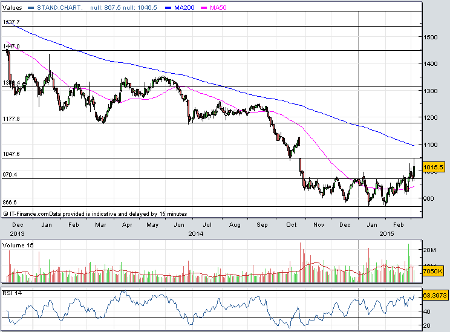Relief rally at Standard Chartered
4th March 2015 13:21
rocketed as much as 7% at one stage on Wednesday after assuaging fears that the lender was about to go cap in hand to investors. A week after chief executive Peter Sands finally handed in his notice, he told a conference call that the bank had "no plans for a capital raise." Instead, there'll be plenty of cost-cutting and asset sales as part of a drive to improve its financial strength.
And there's clearly plenty of work to be done. Pre-tax profit slumped by a quarter to $5.2 billion and statutory profit, which includes $758 million of goodwill impairment and a US civil penalty of $300 million, fell by 30% to $4.2 billion. Normalised return on equity was 7.8%.
"Worse than forecast, better than feared," says Numis Securities. "Underwhelming," reckons Investec.
Technical trade
But our resident technical analyst John Burford is not as interested in the fundamentals. "I have a very bullish picture on the long-term and short-term charts," says John who sets out a series of potentiall chart moves which could see the shares trade as high as £20. Read here to find out how.
Back to the numbers
At least the capital position was ahead of estimates, despite the Common Equity Tier 1 (CET 1) ratio - a measure of financial strength - easing to 10.7% from 11.2% in 2013. Standard has increased its target for 2015 and beyond to 11-12%. And there is a god chance it can achieve this.
Standard cut about $9 billion of low returning risk-weighted assets (RWA) in 2014, mainly from the corporate & institutional clients business, and saved a further $2 billion from disposals. And the bank now plans to "pull these levers even harder," targeting cuts of another $25-30 billion of RWA from low-returning client relationships and underperforming businesses.

"We are making good progress on this already,” it says. “By taking these actions we are confident that we can achieve our target CET1 ratio of 11 to 12 per cent in 2015 and thereafter."
This confidence is borne out by the decision to keep the dividend at 86 US cents, which puts the bank on an historic yield of 5.4%, on a par with .
Of course, things may change with the arrival of ex-JP Morgan man Bill Winters in June. A target for return on equity of over 10% in the medium term may be too modest for the former Wall Street banker. "The fundamental problem remains though that a 10% ROE isn't nearly enough to get SC self-financing - the balance sheet must grow much faster than the 5% a 10% ROE can finance to meet natural wage and control inflation," says Deutsche Bank. It also reckons consensus estimates are still too high.
"We believe shareholder value creation is better served by raising capital and restructuring more aggressively. We have SC trading at 11.4x 2016 EPS, 1.0x TNAV for an 8% return on tangible equity (ROTE)."
This article is for information and discussion purposes only and does not form a recommendation to invest or otherwise. The value of an investment may fall. The investments referred to in this article may not be suitable for all investors, and if in doubt, an investor should seek advice from a qualified investment adviser.
Editor's Picks